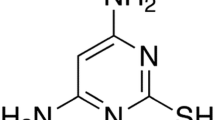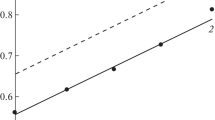Abstract
The corrosion characteristics of both pure and amalgamated zinc have been studied in 6.0 M NH4 Cl using steady-state polarization and a.c. impedance methods, and the influence of methylcellulose-coated and uncoated paper separators have been determined. Irrespective of the type of separator present, the results can be interpreted almost exclusively in terms of charge-transfer effects. In the presence of the base paper the anodic zinc dissolution process is inhibited by 79% whilst the rate of cathodic hydrogen evolution is inhibited by only 43%. Similarly, in the presence of the complete methylcellulose-coated separator formulation the anodic reaction is inhibited by 98–99% whilst the cathodic reaction is inhibited by only 60–74%. In either case it is shown that the anodic inhibition is considerably greater than that expected on the basis of a simple blocking type model, whereas the cathodic inhibition is considerably less. Evidence is presented which suggests that the excessive inhibition of the anodic current is a consequence of the specific influence of the separator on the stability and adsorption behaviour of Zn(I) intermediates in the zinc dissolution reaction. It is also postulated that the deficient inhibition of the cathodic current may result from the small size and high mobility of the proton which allows it to penetrate those regions of the metal-separator interface normally inaccessible to bulkier ions.
Overall, the corrosion-inhibiting efficiency of the base paper is 41% whilst that of the complete methylcellulose-coated paper separator formulation is 70–75%. These results reflect a substantial influence of the separator material on the corrosion behaviour of zinc.
Similar content being viewed by others
Abbreviations
- m :
-
measured (superscript or subscript)
- c :
-
calculated (superscript or subscript)
- A me :
-
measured area fraction of electrolyte assumingA me =V me /θ m
- A ce :
-
calculated area fraction of electrolyte assumingA ce =V ce /θ c
- l :
-
average length of pores in separator
- r c :
-
resistance of electrolyte within the coating layer
- r e :
-
resistance of ‘free’ electrolyte having an equivalent thickness and geometry of that of the free base paper or coating layer
- r p :
-
resistance of electrolyte within the base paper
- r s :
-
resistance of electrolyte within the base paperor coating layer
- R Ω :
-
total resistance of electrolyte between Luggin probe and zinc surface in the absence of a separator
- R pΩ :
-
total resistance of electrolyte between Luggin probe and zinc surface in the presence of the base paper only
- R sΩ :
-
total resistance of electrolyte between Luggin probe and zinc surface in the presence of the coated paper separator
- t c :
-
thickness of coating layer (t c=30 μm)
- t p :
-
thickness of base paper (t p=185 μm)
- V me :
-
measured volume fraction of electrolyte in the separator
- V ce :
-
calculated volume fraction of electrolyte in the separator assumingr s/r e=1/V 3e
- x :
-
constant distance between zinc surface and Luggin probe (absence of separator) or between Luggin probe and free electrolyte exposed (outer) separator surface (presence of separator) (x=0.10 cm)
- θ m :
-
measured (experimentally derived) tortuosity factor assuming measured volume fractionV me and relationr s/r e =θ 2/V me
- θ c :
-
calculated tortuosity factor assumingθ = 1/V ce
- ϱ:
-
resistivity of free electrolyte
- \(\bar \rho \) :
-
resistivity of the separator
- b a :
-
anodic Tafel slope (mV per decade)
- b c :
-
cathodic Tafel slope
- i a :
-
anodic current in the Tafel region
- i c :
-
cathodic current in the Tafel region
- i sa :
-
anodic current in the Tafel region in the presence of the separator
- i sc :
-
cathodic current in the Tafel region in the presence of the separator
- i extcor :
-
corrosion current derived by extrapolation of anodic and cathodic current-potential data
- I s :
-
current inhibition (%) due to the separator
- Δη :
-
shift in overpotential produced by the separator
- φ e :
-
area fraction of electrolyte adjacent to the zinc surface calculated assuming a 1∶1 correlation between separator coverage and current inhibition
- φ p :
-
area fraction of solid (polymer) adjacent to the zinc surface assuming a 1∶1 correlation between separator coverage and current inhibition
- C dl :
-
double-layer capacity
- E cor :
-
corrosion potential
- \(i_{cor}^{R_{dc} } \) :
-
corrosion current derived fromR dc value
- \(i_{cor}^{R_p } \) :
-
corrosion current derived fromR p value
- i batcor :
-
battery corrosion current derived by extrapolation of cathodic Tafel line back to zinc potential in complete Leclanché electrolyte
- I cor :
-
corrosion current inhibition
- I batcor :
-
battery corrosion current inhibition
- R ct :
-
charge-transfer resistance
- R dc :
-
direct current resistance extrapolated from impedance data (Z)ω=0
- R p :
-
polarization resistance (dE/di) i→0
References
L. M. Baugh,Electrochim. Acta 24 (1979) 657.
, ibid.Electrochim. Acta 24 (1979) 669.
L. M. Baugh, R. J. Field and J. A. Lee,25 (1980) 751.
L. M. Baugh, P. M. Gidney and J. A. Lee,25 (1980) 765.
L. M. Baugh, F. L. Tye and N. C. White, in ‘Power Sources 9’ (edited by J. Thomson), Academic Press, London (1983) p. 303.
,J. Appl. Electrochem. 13 (1983) 623.
L. M. Baugh and A. Higginson,J. Power Sources 13 (1984) 297.
L. M. Baugh and N. C. White, paper presented at 15th International Power Sources Symposium, Brighton, UK, September, 1986, to be published in ‘Power Sources II’ (edited by L. Pearce) (1987).
,J. Appl. Electrochem. 17 (1987) 1037.
C.R.C. Handbook of Chemistry and Physics, 57th Edn, C.R.C. Press, (1977).
L. M. Baugh and A. Higginson,Electrochim. Acta 30 (1985) 1163.
T. Hurlen and K. P. Fischer,J. Electroanal. Chem.,61 (1975) 165.
J. O'M. Bockris, Z. Nagy and A. Damjanovic,J. Electrochem. Soc. 119 (1972) 285.
F. L. Tye,Chem and Ind. May (1982) 322.
J. A. Lee, W. C. Maskell and F. L. Tye, in ‘Membrane Separation Processes’ (edited by P. Meares), Elsevier, Amsterdam (1976) p. 425.
A. Agopsowicz, R. Brett, J. E. A. Shaw and F. L. Tye in Power Sources 5 (edited by D. H. Collins), Academic Press, London (1975) p. 503.
C. Cachet and R. Wiart,J. Electroanal. Chem. 111 (1980) 235.
M. Stern and A. L. Geary,J. Electrochem. Soc. 104 (1957) 56.
M. Stern,Corrosion 14 (1958) 440.
Author information
Authors and Affiliations
Rights and permissions
About this article
Cite this article
Baugh, L.M., White, N.C. Influence of methylcellulose-coated paper separators on the corrosion, polarization and impedance characteristics of zinc in concentrated ammonium chloride solution. I. Behaviour in flooded electrolyte. J Appl Electrochem 17, 1021–1036 (1987). https://doi.org/10.1007/BF01024368
Received:
Revised:
Issue Date:
DOI: https://doi.org/10.1007/BF01024368




